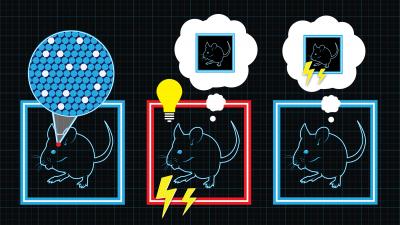False memories implanted in mice show how easily it is to manipulate recall of events.

Image credit: Collective next- taken from the press release (25/7/13): False memories incepted into the mouse brain shed light on the neural basis of the human phenomenon. Red and blue boxes represent two separate environments.
Memory is a phenomenon like no other. The ability to recall events which occurred in the past helps cognitive beings to anticipate the outcomes of similar happenings and allows the build up of experience which can be hugely informative. Scientists have identified the ‘engram-bearing’ cells of the hippocampus of the brain as the units of storage of such long-term memories. The past is recalled from groups of these ‘engram-bearing’ neurons in assemblages which log information. When this information is accessed, by way of ‘engram-bearing’ cell activation, a memory is recalled.
Many have seen the film, Inception. The idea at the centre of the whole plot is a fascinating and sinister one- the ability to implant ideas and memories in the mind of another (in the film, via the infiltration of a subject’s dreams) would confer limitless power.
Intriguingly, scientists at the RIKEN-MIT Center for Neural Circuit Genetics and MIT's Picower Institute for Learning and Memory, have come fascinatingly close to achieving this very thing, in a study published in Science and released into the public domain on 25th July 2013. They have managed to implant false memories of fear, associated with a particular environment, into the brains of transgenic mice.
As part of ongoing research into mechanisms of memory, researchers produced a transgenic mouse-line whose ‘engram-bearing’ neurons in the hippocampus (associated with the formation of long term memories and recollection of experience) could be activated and caused to fire by exposure to light. Hence, a memory could be ‘turned on’ simply by having light fall on the cells.
In the ‘inception’ experiments, the mice were placed in a safe environment for a short period in order that they formed a memory of being in that first environment. Subsequently, they were moved to a second, distinct environment. In the second environment, the ‘engram-bearing’ cells were exposed to pulses of light, and hence recollection of the first environment was induced. While the mouse was recalling the conditions of the first environment, it was also exposed to small electrical shocks at its feet. This created a false association; that of pain/fear with the first environment. In effect, the scientists had planted a ‘false memory’ into the mind of the mouse. When placed back in the safe, first environment, the mice exhibited fear responses, as if they were recalling being shocked when they were placed in the first environment previously.
This ‘false memory’ caused the same fear centres in the brain to become active as would activate if real aversion was being recalled. This suggests that the mouse’s brain could make no distinction between the ‘false’ memory, and a real one- we could speculate that the mouse ‘felt’ as if the aversive conditions really had been experienced on initial exposure to the first environment. More impressive still, was that, once the researchers had implanted the false memory, they could cause it to be recalled at their will, simply by shining light on the transgenic murine hippocampal cells.
While an impressive achievement in itself, this study highlights how malleable memory is. It can be distorted and altered remarkably easily, by exposure to external influences, perhaps at a later point in time. This sheds light on the reported phenomenon of humans being able to recall and report on experiences they never had, and throws into question how reliable eyewitness account of events might be. Perhaps simply accessing memories by ‘engram-bearing’ neuron activation can alter the content of such memories, and perhaps, events occurring while recalling an event can affect how that event is remembered in future. This research in mice strongly suggests this.
While inception of this kind in humans is still firmly in the
realm of science fiction (and where it should stay, in my opinion), it is
unequivocal that further study and experimentation using such a murine line will
be invaluable if we are to fully figure-out memory, one of the more mysterious
aspects of the human (and animal mind). Perhaps memories are more easily
manipulated if the stimulus used to create the false memory is a painful one.
After all, pain is the body’s indicator that it is in harm’s way, hence it
would be unwise to ignore stimuli which generate it. Would the same ‘false
memory’ affect be generated if a food smell were the stimulus that a mouse was
exposed to when recalling the conditions of the first environment? Very
possibly, given that food is almost as essential to survival as the avoidance
of pain. What if the stimulus used were a high-pitched tone?
Is this first in a series of groundbreaking investigations allowing eventual mind control and manipulation? Perhaps not, but it is certainly high-impact, and one to be earmarked, perhaps ‘remembered’ for future reference.
Citation: Press release (25/7/13): ‘False memories incepted into the mouse brain shed light on the phenomenon in humans.
Ramirez et al. "Creating a False Memory in the Hippocampus" Science, 2013.




Comments